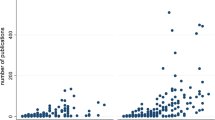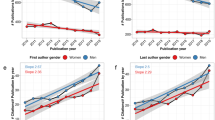Abstract
Background
To date, no data exist on gender-related publication biases in nephrology. This study was conducted to determine whether gender differences exist in the current literature published in high-ranking US nephrology journals, and how they may have changed over time.
Methods
The PubMed search was performed using the easyPubMed package in R, which extracted all articles indexed in PubMed from 2011 to 2021 from the US nephrology journals with the highest impact factors, i.e., Journal of the American Society of Nephrology (JASN), American Journal of Nephrology (AJN), American Journal of Kidney diseases (AJKD), and the Clinical Journal of the American Society of Nephrology (CJASN). Gender with predictions > 90% were accepted and the remaining were manually identified. Descriptive statistical analysis was carried out on the data.
Results
We identified 11,608 articles. On average, the ratio of male to female first authors decreased from 1.9 to 1.5 (p < 0.05). Additionally, in 2011, women accounted for 32% of first authors, a number that rose to 40% in 2021. All but the American Journal of Nephrology showed a variation in the ratio of men to women first authors. For the JASN, the ratio changed from 1.81 to 1.58, p = 0.001, for CJASN, the ratio declined from 1.91 to 1.15, p = 0.005 and for AJKD, the ratio declined from 2.19 to 1.19, p = 0.002.
Discussion and conclusions
Our study shows that gender biases in publications continue to exist in first-author publications in high-ranking Nephrology journals published in the US; the gap is however closing. We hope this study lays the groundwork to continue following and evaluating gender trends in publication.
Graphical Abstract



Similar content being viewed by others
Data availability
Data are available at https://doi.org/10.6084/m9.figshare.20324067
References
AAMC (2018-2019) The state of women in academic medicine: exploring pathways to equity. https://www.aamc.org/data-reports/data/2018-2019-state-women-academic-medicine-exploring-pathways-equity. Accessed 25 Apr 2022
Penny M, Jeffries R et al (2014) Women and academic medicine: a review of the evidence on female representation. J R Soc Med 107(7):259–263. https://doi.org/10.1177/0141076814528893
(2012) Nature’s sexism. Nature. https://doi.org/10.1038/491495a
Lundine J, Bourgeault IL et al (2018) The gendered system of academic publishing. Lancet 391(10132):1754–1756. https://doi.org/10.1016/S0140-6736(18)30950-4
Mehran R, Kumar A et al (2021) Gender and disparity in first authorship in cardiology randomized clinical trials. JAMA Netw Open 4(3):e211043. https://doi.org/10.1001/jamanetworkopen.2021.1043
Help-PubMed (2022) PubMed. https://pubmed.ncbi.nlm.nih.gov/help/#publication-types. Accessed 25 Apr 2022
Historical Data (2022) R package version 0.5.2. https://github.com/ropensci/gender. Accessed 25 Apr 2022
Cameron B, Lincoln M (2015) Jane, John … Leslie? A historical method for algorithmic gender prediction. Digit Humanit Q***
Ruggles S, Flood S et al (2020) IPUMS USA: version 10.0. University of Minnesota, Minneapolis. https://doi.org/10.18128/D010.V10.0
Salsberg E, Quigley L et al (2016) The US nephrology workforce 2016: developments and trends. American Society of Nephrology, Washington
American Board of Internal Medicine (2022) Percentage of first year fellows who are female by specialty. https://www.abim.org/about/statistics-data/resident-fellowworkforce-data/Percentage-of-first-year-fellows-who-are-female-by-subspecialty. Retrieved 15 Apr 2022
Asghar M, Usman MS et al (2018) Sex differences in authorship of academic cardiology literature over the last 2 decades. J Am Coll Cardiol 72(6):681–685. https://doi.org/10.1016/j.jacc.2018.05.047
Whitelaw S, Thabane L et al (2020) Characteristics of heart failure trials associated with under-representation of women as lead authors. J Am Coll Cardiol 76(17):1919–1930. https://doi.org/10.1016/j.jacc.2020.08.062
Dalal NH, Chino F et al (2020) Mind the gap: gendered publication trends in oncology. Cancer 126(12):2859–2865. https://doi.org/10.1002/cncr.32818
Vranas KC, Ouyang D et al (2020) Gender differences in authorship of critical care literature. Am J Respir Crit Care Med 201(7):840–847. https://doi.org/10.1164/rccm.201910-1957OC
Filardo G, da Graca B et al (2016) Trends and comparison of female first authorship in high impact medical journals: observational study (1994–2014). BMJ 352:i847. https://doi.org/10.1136/bmj.i847
Reed DA, Enders F et al (2011) Gender differences in academic productivity and leadership appointments of physicians throughout academic careers. Acad Med 86:43–47
Wing DA, Benner RS, Petersen R, Newcomb R, Scott JR (2010) Differences in editorial board reviewer behavior based on gender. J Women’s Health. https://doi.org/10.1089/jwh.2009.1904
Gilbert JR, Williams ES, Lundberg GD (1994) Is there gender bias in JAMA’s peer review process? JAMA 272(2):139–142. https://doi.org/10.1001/jama.1994.03520020065018
Pohlhaus JR, Jiang H, Wagner RM, Schaffer WT, Pinn VW (2011) Sex differences in application, success, and funding rates for NIH extramural programs. Acad Med 86:759–767. https://doi.org/10.1097/ACM.0b013e31821836ff
Weisshaar K (2017) An assessment of gender gaps in promotion to tenure in academia. Soc Forces 96(2):529–560. https://doi.org/10.1093/sf/sox052
Geiger AW, Livingston G, Bialik K (2019) Six facts about US Moms (Analysis of American Time Use Survey Data). https://www.pewresearch.org/fact-tank/2019/05/08/facts-about-u-s-mothers/. Accessed 25 Apr 2022
Sege R, Nykiel-Bub L, Selk S (2015) Sex differences in institutional support for junior biomedical researchers. JAMA 314(11):1175–1177. https://doi.org/10.1001/jama.2015.8517
Funding
No funding sources.
Author information
Authors and Affiliations
Contributions
RA: Substantial contributions to the conception or design of the work, the acquisition, analysis, and interpretation of data for the work. Drafting the work and revising it critically. Final approval of the version to be published. OA: Substantial contributions to the acquisition, analysis, and interpretation of data for the work. Drafting the work or revising it critically. Final approval of the version to be published. MEO: Substantial contributions to the acquisition, analysis, and interpretation of data for the work. Drafting the work or revising it critically. Final approval of the version to be published. Fatima Iqbal: Substantial contributions to the acquisition, analysis, and interpretation of data for the work. Drafting the work or revising it critically. Final approval of the version to be published. KS: Substantial contributions to the conception or design of the work, the acquisition, analysis, and interpretation of data for the work. Drafting the work and revising it critically. Final approval of the version to be published.
Corresponding author
Ethics declarations
Conflict of interest
The authors have no conflicts of interest to declare.
Ethical approval
Ethics approval was not required.
Consent to participate statement
No human participants were involved in the study.
Additional information
Publisher's Note
Springer Nature remains neutral with regard to jurisdictional claims in published maps and institutional affiliations.
Supplementary Information
Below is the link to the electronic supplementary material.
Rights and permissions
Springer Nature or its licensor (e.g. a society or other partner) holds exclusive rights to this article under a publishing agreement with the author(s) or other rightsholder(s); author self-archiving of the accepted manuscript version of this article is solely governed by the terms of such publishing agreement and applicable law.
About this article
Cite this article
Abraham, R.R., Adisa, O., Owen, M.E. et al. Evaluation of gender trends in first authorship in nephrology publications in four major US journals in the last decade. J Nephrol 36, 1395–1400 (2023). https://doi.org/10.1007/s40620-022-01557-w
Received:
Accepted:
Published:
Issue Date:
DOI: https://doi.org/10.1007/s40620-022-01557-w




